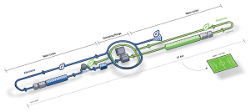 |
 |
|||||||||||||
|
|||||||||||||
|
|||||||||||||
|
New science project in their planning stages are a bit of a hothouse for new ideas, innovative solutions and maybe even breakthroughs in technology. The ILC is right in the middle of this stage: R&D is in full swing, scientists pursue various solutions to meeting the high demands of the machine and detectors. No wonder then that people are already thinking of ways to transfer the technologies developed for the different areas of the ILC to other projects or disciplines: medicine, biology, drug research, computing, environment and many others.
Did you know, for example, that you could one day ride a subway train that was built with ILC experience? The demands on precision metrology and stable facilities are so high that they could be used to map and build subway tunnels for future metros. The continuous monitoring and correcting of the beam, checking against ground movements and detection of noise could lead to better early warning system for earthquakes.
Particle accelerators in general have done a lot for medicine research and many other areas of science. Researchers do not need much convincing to think of a problem as a challenge, and they often turn these challenges into advantages. Take synchrotron radiation, for example: originally a nuisance because it means that particle beams lose energy when they circulate, its uniform and tunable light now drives some 50 light sources around the world. Researchers from all kinds of disciplines take probes and materials to these light sources, and one of the most famous results is the anti-HIV drug Kaletra® that came out of research at Argonne National Lab's Advanced Photon Source ANL (read more about research at APS and the drug). There are some 200 accelerators that exist almost entirely to produce radioisotopes for medical diagnoses, and a whopping 7500 accelerators for radiotherapy. Even though nobody can tell exactly what spin-offs the work on superconducting radiofrequency (SCRF) technology for the ILC will yield the prospects are enormous. “The whole work on cavities has put SCRF on the map. The ILC has been pushing the gradient, reducing the cost,” says DESY's Nick Walker. Developments in technology are often transferred into other sciences. The European X-Ray Free-Electron Laser XFEL is a palpable example for this: planned as a light source to accompany the former TESLA collider, it is now under construction in Hamburg. And the economic benefit for the industry working on parts for big science projects like the ILC is not negligible either, which means that it in turn drives the economy of the industry's country. Detectors are another important technology driver. In fact graduate students are already working on turning detector chips into medical tools. Excited yet? If you want to know more, read the Funding Agencies for Large Colliders (FALC) studies made in each region on possible benefits of the ILC and the global study created from these three. And don't forget to have a look at the four-page summary that has just come out and will be distributed at TILC09! You can also order it from the website.
-- Barbara Warmbein |
|||||||||||||
| © International Linear Collider |

